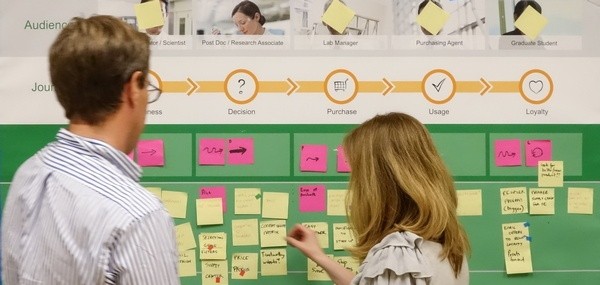Customers today have a dizzying array of channels and touchpoints to choose from when they set out to solve specific pain points.
Which channel(s) they start with and how their purchasing journeys unfold from there are essential in figuring out where, when and how a brand engages with them to get a desirable outcome.
If your message is out of sync, it doesn’t matter if you’re the best solution, your customer will likely pass you by and pick another one that seems to sync better.
The journey mapping exercise, when done well, visualizes customer behavior and interactions across channels, touchpoints and marketing stages. And that is essential in delivering the right message to the right consumer persona at the right touchpoint.

From 5 to 50
1. Specify the customer-facing issues
Over the years, I’ve run customer journey mapping workshops that involved as few as 5 to as many as 30 participants. I’ve had spectacular results and ones that left something to be desired. I’ve learned a few key lessons that have helped me become successful.
If you can answer these questions before you kick-off the exercise, you’ll have much higher odds of getting actionable outcomes from running your own exercises.
- Specific: how do we improve conversions on our site for new purchasers
- Non-specific: how do we optimize our site e-commerce experience
Specificity is critical. Being specific doesn’t mean being narrow, just focused. From years of doing these exercises, I’ve realized that this helps in all aspects from facilitation to finding insights, but most of all in getting the right people to participate, and tell them why we really need them.
2. Are your personas clearly defined?

A lot of customer journey exercises start with the ‘User” or “Segment X”.
This is not a show-stopper. Where it does fall short is in the quality of insights you get at the end.
Empathy is key to mapping a person’s journey. By not being able to visualize the user or segment as a person, people have difficulty mapping that consumer’s journey. What you create is an empathy gap.
For example your Segment X – New purchaser, Woman, 24-35. This can translate to
Persona 1: Urban woman, 26, Professional, Single
Persona 2: Suburban woman, 35, Housewife, 2 kids
It’s far easier to visualize each of the two persona’s journeys over a combined, amorphous “Women, 24-35 segment”.
I’ve seen people struggle to visualize journeys using amorphous Users/Segments, but just add a few persona style attributes, and the change is transformational.
Solution: Create at least ONE persona per segment you’re interested in. Then pick the most important segment’s persona to start with.
3. What stages have the biggest gaps?




Comments
Comment policy: We love comments and appreciate the time that readers spend to share ideas and give feedback. However, all comments are manually moderated and those deemed to be spam or solely promotional will be deleted.